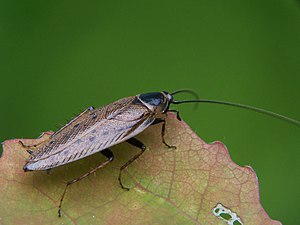Common wood cockroach
| Common wood cockroach | ||||||||||||
|---|---|---|---|---|---|---|---|---|---|---|---|---|

Common wood cockroach ( Ectobius lapponicus ) |
||||||||||||
| Systematics | ||||||||||||
|
||||||||||||
| Scientific name | ||||||||||||
| Ectobius lapponicus | ||||||||||||
| ( Linnaeus , 1758) |

The common wood cockroach or Lapland wood cockroach ( Ectobius lapponicus ) is a European species of wood cockroach . It lives in the open air and is only rarely and exceptionally found in buildings.
features
The cockroaches reach a body length of about 9 to 12, females only up to 10 millimeters. The sexes differ in the formation of the wings. Males are fully winged and capable of flight, the wings of the females are somewhat shortened and do not reach the tip of the abdomen. In addition, the abdomen of the male (when viewed from below) has eight, that of the female only six visible segments. At the rear end of the female is the enlarged, semicircular protruding subgenital plate, from which the ootheca emerges when the eggs are laid . In the male, the tip of the abdomen has a smaller, roughly triangular subgenital plate with an appendix, the stylus, of a species-specific shape. In both sexes, the subgenital plate has paired, segmented appendages that serve as sense organs, the cerci .
The species can usually be recognized by the color and shape of the pronotum . This is evenly rounded, without emphasized rear corners. It has a dark spot in the middle (on the disk), which merges into the lighter edge with blurred borders and blurred edges. On the seventh tergite of the abdomen (i.e. hidden by the wings in the resting position) is the species-specific shaped glandular pit. This is small in the species (much smaller than in the amber wood cockroach ), it is shaped transversely oval, in the middle with a dense, two-part tuft of hair.
Nymphs of the species are predominantly straw-yellow to dark yellow in color and have small dark spots on the upper side. The last stages are somewhat darker, with a confluence of dark spots on the abdomen. The dark markings on the pronotum disk, if present, always have faded edges. The species has five larval stages. In the latter, clear wing sheaths can be seen, which reach the end of the third segment of the abdomen in the male and the second segment in the female.
distribution
The species lives in most of Europe, east to the Urals. It is absent in Great Britain , the Iberian Peninsula and southern Italy. It was introduced to North America as one of four Ectobius species. The first record there comes from 1984 from New Hampshire , today it is widespread in the northeast of the continent. It occurs in Canada in Ontario , Nova Scotia and New Brunswick and on Prince Edward Island .
habitat
The species occurs predominantly in forests. Males and nymphs are found preferentially in the ground vegetation and the shrub layer, females more on the ground and in the litter layer. Males are active during the day, preferably in the afternoon, while females and nymphs tend to be nocturnal. The animals are usually active from around May to September.
Rarely and exceptionally, individual animals penetrate houses, but they cannot reproduce there.
Reproduction
The females lay 20 eggs each in the relatively small ootheca . The oothecae of this species are reddish brown in color and striated across. The common wood cockroach can optionally reproduce parthenogenetically . Females with oothecae can be found around June. You carry these around with you for about 24 hours and eventually hide them in the leaf litter or in the felt.
Like almost all wood cockroaches, the species has a two-year development cycle ( semivoltin ). After the ootheca has been deposited, the eggs hibernate in it and the nymphs hatch the following year, around June. The nymphs then develop in the fourth stage and overwinter again, often inside grass bulbs. They become active again around April the following year and continue to develop. The first adults can be found in May.
swell
- ^ A b Hannes Baur, Isabelle Landau-Lüscher, Gabi Müller, Marcus Schmidt & Armin Coray: Taxonomy of the amber wood cockroach Ectobius vittiventris (A. Costa, 1847) (Blattodea: Blattellidae) and its distribution in Switzerland , Revue Suisse de Zoologie 111 (2): 395-424; juin 2004 ( PDF, 4.2 MB ( Memento of the original from August 24, 2015 in the Internet Archive ) Info: The archive link has been inserted automatically and has not yet been checked. Please check the original and archive link according to the instructions and then remove this notice. )
- ↑ a b Horst Bohn: Blattoptera - cockroaches. In: Stresemann - Exkursionsfauna von Deutschland, Volume 2: Invertebrates: Insects. Springer-Verlag, 2011. ISBN 978 3827424525
- ^ Danilo Matzke (2013): Contributions to the insect fauna of Saxony. A contribution to the knowledge of the larvae of Saxon cockroaches. Messages from Saxon Entomologists 32 (105): 68-71.
- ↑ Jeff C. Clements, Denis A. Doucet, David B. McCorquodale (2013): Establishment of a European cockroach, Ectobius lapponicus (L.) (Dictyoptera: Blattodea), in the Maritime Provinces of eastern Canada. Journal of the Acadian Entomological Society 9: 4-7.
- ↑ U. Mielke (2000): About the appearance of the Lapland cockroach (Ectobius lapponicus [Linné 1758]) in buildings. Pest Indicator 73 (6): 152-154.
- ↑ Jaroslav Holuša 6 Petr Kočárek (2000): Seasonal dynamics of the dusky cockroach Ectobius lapponicus (Blattodea, Blattellidae) in the eastern part of the Czech Republic. Biologia, Bratislava 55 (5): 483-486.
Web links
- Ectobius lapponicus in Fauna Europaea